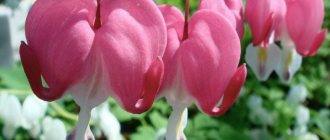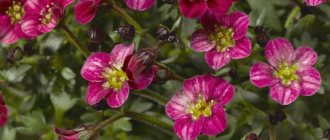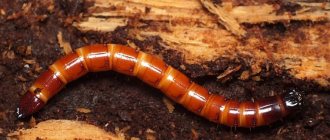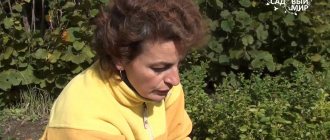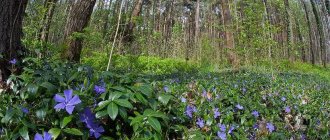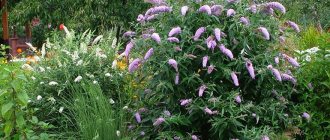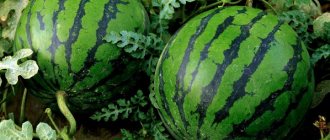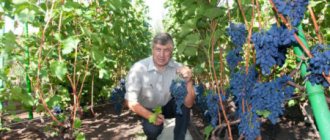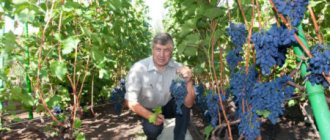Strawberry is a type of strawberry called nutmeg. Most strawberry varieties are characterized by dioeciousness.
This is a perennial plant with a collection of short stems, a rosette of basal leaves and three types of shoots: horns, tendrils, and peduncles.
The root system is fibrous.
The fruits are prefabricated achenes: the seeds-nuts are attached to an overgrown juicy receptacle, which is commonly called a berry.
To achieve a good harvest, it is important to follow the agricultural techniques for growing strawberries.
Although this crop can grow in one place for up to 10 years, its yield will decrease every year.
Therefore, strawberries are cultivated in one bed for no more than 3–5 years, and remontant ones for 2–3 years.
All about strawberries
Perhaps this is the most favorite garden crop. However, growing it is a rather difficult task that requires a responsible approach.
Botanical description
Strawberry (garden strawberry) is a perennial that bears fruit. The plant is a small bush with a height of 15 to 40 cm. Its trifoliate leaves are characterized by a pronounced green color and jagged edges. Inflorescences in the form of a multi-flowered shield consist of 5-12 light buds.
Since garden strawberries are a bisexual plant, planting other bushes next to them for pollination is not required .
The berries of most varieties are cylindrical or conical in shape. Their full ripening is indicated by a rich red hue. In scientific terminology, strawberry fruits are called polynuts . The light yellow colored seeds of the plant are located on the surface of the peel.
Important! The correct name for the berries grown in the plots is garden (pineapple) strawberry .
What does the berry like?
When growing garden strawberries, it is worth considering several nuances :
- Plant the crop in areas with flat or south-west sloping surfaces. Places with southern slopes and in lowlands are undesirable.
- The optimal soil type is slightly acidic, loamy or sandy loam, fed with humus or organic fertilizers.
- Despite the fact that strawberries are a moisture-loving crop, they cannot tolerate excessive waterlogging. Therefore, in areas with close groundwater, high ridges must be formed for planting.
Growing methods
There are several options for cultivating this garden crop.
Important! In addition to traditional planting in open ground, technologies involve the use of different containers and differences in relief, which is especially important for small areas and rooms.
Standard - in open ground
As a rule, when growing strawberries in open ground, two main methods are used:
- single-line – a distance of 60 cm between single rows and 15 cm between the bushes located in them;
- two-line - the interval between rows is 30 cm, between bushes - 20 cm.
To obtain a bountiful harvest, a single-line planting method is recommended. With rows located close to each other, more crops can be harvested from 1 m2.
At the same time, two-line planting helps to successfully survive the drop in temperature, since the bushes in the rows are denser. Therefore, this growing method is optimal for regions with cold climates.
Non-standard methods
The disadvantage of traditional cultivation of this berry is the impossibility of obtaining a large harvest in small areas. After all, to create beds you will need sufficient space. In this case, gardeners use unconventional methods, using various materials and designs. The most common:
- Vertical structures. Cultivation of berries using this technology can be carried out in several ways, each of which is simple to implement. For this purpose, they purchase ready-made structures or make them themselves from pipes, tires, pots, barrels, construction mesh, etc.
- Under agrofibre. Bushes planted in the ground are covered with agrofibre with slots made. Garden strawberries grown in this way tolerate the adverse effects of external factors well and produce a bountiful harvest.
- In film tunnels. Metal arcs about ½ m high are mounted above the beds and covered with polyethylene. This creates a greenhouse effect and protection from sudden temperature changes.
- In bags. Strawberries are grown in plastic bags filled with fertile substrate, changing it periodically. The advantage of this technology is mobility. Agrotechnical activities are carried out according to a standard scheme.
Types of beds
Strawberry agricultural technology provides for several types of beds:
- Traditional: the height of the bed varies from 20 cm to one meter.
- Pyramids made of wooden structures.
- Vertical: This type uses tall barrels or pipes filled with substrate.
- Bags with pockets: these are filled with soil and attached to a stable support.
- German: the bed is made inside a box made of boards or slate.
Growing strawberries in vertical pipes saves greenhouse space
Planting strawberries
The event associated with planting this garden crop includes several stages.
Determining timing - when to plant?
The right time to plant strawberries depends on the climate of the area where you plan to grow them, for example:
- southern regions - the first ten days of September;
- The middle zone of the Russian Federation - from the beginning of August to the end of September, from the end of March to mid-April;
- northern regions - from late May to mid-July.
Important! The recommended air temperature for planting strawberries in spring is from +15 to +25°C .
Selecting a location
The place for the berry garden should be well lit and exposed to direct sunlight for about 10 hours a day. Two types of soil are preferred:
- loam – retains moisture well, allows air to pass through and is quickly warmed by the sun;
- sandstone – has excellent air and water permeability, dries quickly without forming a crust on the surface.
The optimal level of soil acidity (pH) should be in the range of 5.5–6.6. The occurrence of groundwater is no closer than 0.8 m to the surface of the earth.
Predecessors
Ideal predecessors for planting strawberries:
- greens: basil, parsley, lettuce, dill and cilantro;
- garlic;
- legumes;
- all types of cabbage;
- beet;
- carrot;
- radish;
- radish;
- turnip;
- marigold;
- daffodils;
- tulips.
It is not advisable to plant garden strawberries after tomatoes, potatoes and all pumpkin plants: melons, zucchini, watermelon, pumpkins, cucumbers.
Landing technique
Preparations for spring planting begin in the fall. Approximately 6 months before, the soil is dug up along with wood ash and humus.
Important! If for some reason the fertilizing was not applied in advance, it is placed directly into the planting holes.
Preparatory work related to the autumn planting of strawberries is carried out several weeks in advance: the soil is dug up with humus and wood ash. Planting berries in spring and autumn is carried out using the same technology :
- immerse the roots of the bushes in a clay mash;
- form holes with a depth of about 10 cm;
- pour ½ liter of water into each cavity;
- place seedlings in the holes and sprinkle with soil to the level of the root collar.
Preparing for winter
In the Moscow region, as well as in the Northern regions, strawberries need to be prepared for winter. It may not withstand frosts (at -20 degrees the rhizomes freeze), especially if there is little snow in winter. For this:
- In October, strawberry beds are covered with sawdust and peat mulch with a layer of 5-6 cm.
- In November, the bushes are covered with coniferous branches, pine spruce branches, straw, hay, agrofibre, agrotex or spunbond so that snow lingers on the beds. When frosts reach -8 degrees, strawberries should be covered with a 10-12 cm layer of snow.
Strawberries require care almost all year round, but in return they generously reward gardeners for their care and attention.
Growing strawberries from seeds
The process of cultivating garden strawberries from self-collected seeds consists of several stages.
Stratification
This procedure, necessary for obtaining friendly shoots, is carried out as follows:
- The seeds are laid out on the surface of a cotton pad soaked in water, covered with a second one and placed in a small container with a lid.
- The container is left for 2 days in a warm place, and then for the same amount of time in the refrigerator.
For 2 weeks, the seeds are placed alternately in heat and cold, opening the container daily for ventilation.
Germination of seeds
Seeds that have passed stratification are placed on a napkin folded in several layers and sprinkled with rain or melt water. Place everything in a plastic bag and leave it in a bright place with a temperature of at least +25°C . As the bundle dries, it is moistened, and the condensation that appears is removed.
Important! When germinating, seeds should not be in excess liquid.
Seeds of varieties characterized by not very large berries germinate in a week under ideal conditions.
To plant sprouted seeds, plastic cups, peat tablets or a container box are most often used.
Suitable substrate
The substrate for sowing strawberry seeds should be crumbly and light. When preparing it yourself, you should use examples of its approximate composition:
- sand and forest soil (1:1);
- peat, vermicompost and sand (1:1:1);
- turf, peat and sand (2:1:1).
Important! Before mixing peat with other components, it is deoxidized using lime or dolomite flour.
Care after sowing
Growing strawberry seedlings includes the following procedures:
- watering - performed at the root using a syringe, using only well-settled or purified water;
- fertilizing - compounds containing phosphorus, magnesium and potassium are added to the substrate;
- prevention against fungal diseases - once every 20 days, fungicide treatment is carried out.
Important! Picking is performed only after each seedling has formed 3 full leaves .
Landing in the ground
Planting strawberry seedlings in the ground occurs according to the following algorithm:
- abundant moisture of seedlings in containers;
- creating holes 10 cm deep;
- removing seedlings from containers and transferring them to planting pits;
- filling empty space with soil;
- watering.
Bush care
In order to consistently get a good harvest, strawberries require comprehensive care, which includes timely watering, fertilizing, loosening and weeding.
Watering
Garden strawberries need regular watering, especially if they grow in loam. It is best to moisten the soil in the morning . Before the first flowers appear on the bushes, it is permissible to use the sprinkling method.
When watering blooming strawberries, it is important to prevent moisture from getting into the flowers. In this case, drip irrigation is recommended.
During the first time after planting the crop in the ground, special attention must be paid to watering, since the plant has been able to take root well. In the future, you should stick to the frequency: 1 time every 2-3 days (depending on weather conditions).
Important! If the soil is excessively moistened, the plant loses its resistance to various diseases and frosts.
Feeding
To prevent the berries from losing their sweetness and becoming small, it is necessary to timely apply fertilizer to the soil . During the growing season, strawberries are fertilized 3 times: before the first flowers form, upon completion of fruiting, and in preparation for winter.
Important! If strawberries grow on infertile soil, regular fertilizing with organic and mineral compounds is recommended.
Adding nitrogen to the soil is the key to the full development of bushes and obtaining a bountiful harvest. Also, during autumn digging, phosphorus and potassium are added to the soil , which promote the growth of rhizomes and add sweetness to the berries.
It is acceptable to replace mineral fertilizers with chicken droppings or manure diluted with water. However, in this case, strict adherence to the dosage is necessary, since an excess leads to a deterioration in the condition of the plant itself and the quality of the crop.
Spring feeding
The first feeding of strawberries in the spring is carried out after clearing last year's debris from the berry garden, removing old tendrils and loosening the soil. At this time, it is advisable to use copper-containing preparations that eliminate various bacteria.
You can also use compositions prepared independently for spring feeding:
- Infusion of bird droppings and water (200 g/10 l). The product should only be applied between the rows, as getting it on the bushes can cause burns to the rhizomes and leaves. The use of bird droppings is permissible no more than once per season, otherwise excess nitrates will accumulate in the soil.
- A mixture of mullein, nitroammophoska and water (50 g/15 g/10 l). Recommended dosage – ½ liter for 1 bush.
- Nutritional yeast diluted in water (1 kg/10 l). To obtain a working composition, the resulting infusion is diluted with water to a volume of 20 liters. The finished product is used at the rate of ½ liter for 1 bush.
The second time, fertilizers for garden strawberries are applied in the spring after the first ovaries appear . If for some reason this did not work out, fertilizing is carried out already at the beginning of the fruiting period. For this purpose, you can use compositions prepared according to the following recipes:
- Dilute boric acid, iodine and wood ash in water in a ratio of 5 g/20 drops/1 glass/10 l. Dosage – ½ l for 1 bush.
- Fill a bucket (10 l) halfway with rye bread crusts, then add water and leave to infuse in a dark place for 5-6 days. Then dilute with another 10 liters of water. Apply 1 liter to each bush.
Autumn feeding
When preparing garden strawberries for winter, fertilizers are applied twice:
- in the first ten days of September;
- before the onset of the first frost.
The benefits of autumn feeding of strawberries are as follows:
- strengthening bushes;
- stimulating the formation of fruit buds for the next season;
- nutrition and improvement of soil quality.
In autumn, you can use all types of fertilizers: organic matter, minerals, complex and combined preparations.
Weed control
The root system of strawberries is located as close as possible to the surface, and weeding can cause serious damage to it. For this reason, it is important to prevent weeds from appearing in the garden bed. You can do this in the following way:
- Clear the area thoroughly before planting. If it is heavily infested, use continuous action herbicides.
- During the growing season, place a layer of mulch (6-8 cm) in the berry garden. Remove it in preparation for winter.
Black agrofilm will help protect strawberries from weeds. At the same time, it is worth remembering that this material creates ideal conditions for the development of pathogenic microorganisms and the appearance of slugs.
Mulching
Mulch reliably protects bushes from various diseases, pests, weeds and dirt.
Where to begin
Any business project begins with drawing up a business plan. The document should detail all aspects of the upcoming activity with an analysis of possible problems, calculation of costs and profits, prospects for the sales market and other points.
Agribusiness initially involves owning land or renting a plot. If the land is privatized and ready for use, then there will be no difficulties in terms of locating a strawberry plantation, but finding a suitable plot for purchase or rent is a matter of time.
What documents are needed
Growing strawberries “for yourself” is one thing, but when it comes to business, you can’t do without official registration. There are two types of registration.
Personal subsidiary plot (LPH)
This format is not a business activity, but involves the production and processing of agricultural products with their subsequent sale. Hiring workers in private household plots is prohibited, i.e. Only family members are allowed to work. Registration of the farm takes place in the local administration. The owner provides information about himself and his relatives, information about the area of the plot and cadastral number, as well as information about the equipment and transport used.
Individual entrepreneurship
Individual entrepreneurs have the right to cooperate with legal entities. The optimal area of land for carrying out business activities is up to 1 hectare. You will have to pay a single income tax of 6%. When registering, indicate the OKVED code 01.13.21 - “growing fruit and berry crops.” The activity is formalized as a peasant farm. This is advisable, since peasant farms open up the chance to take advantage of the right to receive subsidies from the state in order to support domestic producers. Registration takes place in regional authorities. In addition to registering the individual entrepreneur with the Federal Tax Service, the following documents will be required:
- permission to dispose of plant waste and fertilizers;
- certificates of workplaces in accordance with the standards of the Labor Inspectorate;
- permission from sanitary and fire inspections;
- permits and certification of the phytosanitary control service;
- contract for waste disposal and waste removal from the utility service.
Hiring workers
To care for plants and pick berries, you cannot do without personnel, especially in a large field. If we assume that 1 worker covers 2-4 acres per day, and from such an area the harvest occurs every other day for 1-1.5 months (one variety), 2-3 months. (varieties with different ripening periods), it is not difficult to calculate the number of people and, depending on the agreement, their wages. But it’s not just labor that farming needs. The participation of the following specialists is also necessary:
- Manager. Engaged in the purchase of consumables, equipment, seedlings, seeds and fertilizers, controls all processes, maintains contact with representatives of the municipality, and serves as an advertising manager. All this work can be undertaken by the owner of the site.
- Master of agricultural technician. Monitors the continuous cycle of strawberry cultivation, uses modern technologies in its work, observes phytosanitary conditions, controls the norms and timing of fertilizer application, temperature conditions, watering and lighting. Gives appropriate instructions to workers regarding plant care and harvesting.
- Forwarder-driver. The delivery of materials, fertilizers, delivery of harvested crops to customers and other logistics operations are the responsibility of the driver.
- Accountant. The specialist maintains farm records remotely.
Agricultural technology by stages of fruiting
Garden strawberries need regular care in each phase of their development.
After landing
You need to pay special attention to caring for the crop in the first year after planting, since for the full development of its rhizomes, the most comfortable conditions are necessary.
Important! In the first few days after planting strawberry seedlings, water them daily , this speeds up establishment. In the future, the frequency of watering is reduced to once every 2-3 days .
Also, after planting, weed control and regular loosening of the soil are necessary .
During flowering
Activities during the flowering period include:
- Loosening the soil is performed to control weeds and provide oxygen access to the root system.
- Watering is carried out in the evening and morning, in the absence of scorching sun rays. It involves the use of two methods: drip or “under the root”.
- Fertilizing - during this period, one application of fertilizer is quite enough. For this purpose, they resort to complex compounds or boric acid, which helps strengthen the bushes and significantly increases productivity.
- Trimming leaves and tendrils reduces the load on the plant, allowing you to direct all your energy to forming a harvest. It also eliminates shading, which improves the quality of the berries.
- Cutting off excess flowers so that the culture does not waste its energy on their development.
Before harvest
Caring for strawberries before harvesting consists of regular watering and destruction of weeds. At the same time, it is important to prevent waterlogging of the soil, which causes rotting of not only the roots, but also the berries.
After harvest
During this period, the plant begins to form young leaves and flower buds for the next season. Caring for garden strawberries after picking the berries includes the following elements:
- Removing old and damaged leaves.
- Mustache trimming.
- Fertilizer application (1-2 times with an interval of 2 weeks).
- Moistening the soil - 1-2 times a week to a depth of 5-8 cm.
- Treatment for the purpose of preventing pests and diseases - for this they use Fitosporin, Fitoverm, Actellik, a weak solution of potassium permanganate, etc.
Features of growing different varieties
Repairing strawberries
Remontant varieties are distinguished by repeated fruiting and large berries. There are some nuances in the process of growing and caring for this crop:
- Removing flower stalks that appear in the spring from young plants, allowing for an increase in the second harvest.
- Planting a new bed every year (the best time for this is from July to September).
- Cleaning bushes that have completed their fruiting from the garden.
- Constantly maintaining a moist environment, soaking the soil to a depth of at least 3 cm, and during the fruiting period - 5 cm.
- Apply fertilizing 4 times per season: before planting, during the flowering period, upon completion of the first harvest, after replanting in the fall.
- Pruning done immediately after harvest.
- Regular weeding (until the first frost).
Soil preparation
On wet soils and in lowlands with close groundwater, strawberries should be grown in high beds; they are made at least 35-40 cm high and 1 meter wide. On hills and in dry places, the ridges are made low 8-10 cm, or they are dispensed with altogether.
On loams, add a bucket of peat, manure or humus per 1 m2 to the soil. On sandy soils - a bucket of peat, turf soil, humus and 3-4 kg of sawdust. The beds are dug to a depth of 30-35 cm, while removing weeds and pest larvae.
After digging, the ridges are leveled and covered with a 2 cm layer of coarse sand, which prevents the development of centipedes, slugs and snails.
Immediately before planting, the soil is dug up again to a depth of about 30 cm in order to saturate it with oxygen.
Timing and features of transplantation
You can transplant garden strawberries at different times:
- in spring - before flowering begins;
- in summer - after fruiting;
- in autumn - in September (except for regions with a harsh climate).
Important! Strawberry transplantation refers to the procedure of rejuvenating bushes through propagation.
Reproduction methods
You can propagate garden strawberries in one of three ways:
- Rosettes (rooting of mustaches) - rosettes with a mustache taken from each bush are placed in separate containers.
- By dividing the bush - the fibrous root of the strawberry is divided into several separate parts.
- Growing from seeds - as a rule, this technology is used to develop new varieties.
How to choose seedlings
You can buy strawberry seedlings or use your own planting material.
A good seedling has 3-4 leaves, the excess ones need to be cut off, and the fibrous root is no longer than 7 cm, otherwise it should be shortened.
The plant must be absolutely healthy.
Before planting, for better survival, the roots are dipped in an aqueous solution of humus, soil and a growth regulator.
It is better to buy seedlings in specialized nurseries, choosing varieties adapted for cultivation in a given region.
You cannot purchase seedlings with wrinkled, dry or pale leaves. This appearance indicates a disease of the plant.
Berry diseases and pests
insects most often attack strawberries :
- ants;
- woodlice;
- types of mites: earthen, transparent, spider;
- slugs
The main method of pest control is strict adherence to the rules of agricultural technology . If insects appear, the crop is treated with chemicals (insecticides), and during the growing season - with biological ones.
The most common strawberry diseases :
- gray rot;
- brown or white spotting;
- powdery mildew.
To prevent these diseases, it is necessary to maintain the correct microclimate; to eliminate the problem, treat the bushes with fungicides.
TOP best strawberry varieties
In order to consistently get a good harvest, it is important to choose the best varieties of strawberries for planting. They must be resistant to diseases and pests, have high taste and aroma. Currently, breeders have developed many varieties that meet different criteria.
The most productive
The TOP 5 best strawberry varieties, characterized not only by high yields, but also by impeccable taste, include:
- Festival chamomile is a mid-season variety, relatively resistant to diseases, and distinguished by semi-spreading compact bushes and bright red berries. Productivity - 500 g per bush, weight of berries from the first harvest is 45 g, subsequent ones - 10 g.
- Gigantella Maxi - the variety is characterized by vigorous bushes, undemanding to soil and moisture. The fruits weighing 100 g have a pleasant aroma, dense pulp and a taste similar to pineapple.
- Vima Zanta is an early ripening, high-yielding Dutch variety. The berries have a delicate aroma and sweet juicy pulp.
- Darselect is an early variety characterized by a fairly short interval between flowering and ripening. The weight of the berries can range from 30 to 50 g. The fruits are heart-shaped, dense pulp and sweet taste.
- Symphony is a mid-late variety, distinguished by powerful bushes with hard dark green leaves. The smooth, large fruits have a conical shape and sweet, juicy pulp. In addition to high yield, the variety is characterized by good keeping quality.
Varieties with sweet and juicy berries
TOP 5 varieties of strawberries with maximum sweetness and juiciness of berries:
- Anastasia - medium-late ripening, resistance to pest attacks and diseases, high yield. The berries, weighing up to 9 g, have a conical shape and a bright scarlet color.
- Eldorado - weight 100 g, yield 1.5 kg per bush. The fruits are characterized by a dense structure, increased sugar content and the ability to withstand long-term transportation.
- Carmen - tall, powerful bushes that bear fruit abundantly. The taste of the berries combines several notes: nutmeg, caramel, honey and citrus. The burgundy color indicates full ripening of the fruit.
- Christina – abundant yield, good immunity to infectious diseases. High indicators of transportation and keeping quality. Red berries weighing 40 g are distinguished by their unique aroma, juiciness and regular shape.
- Honey - high yield, the ability to transport, the ability to maintain its original marketability and taste for a long period, and resistance to temperature changes. Berries weight 40 g.
The best remontant varieties
TOP 5 remontant strawberry varieties that bear fruit throughout the season:
- Albion has a pronounced aroma, high sugar content, transportability, the ability to produce up to 4 harvests during the season, good immunity to diseases and pests. Productivity up to 2 kg per bush, weight 30-50 g.
- Mara de Bois - weight up to 26 g, easy to care for, high yield, pleasant aroma and rich taste. Long-term fruiting (before the onset of frost).
- Queen Elizabeth II - weight 60 g, dense pulp, sweet taste. The ability to easily endure transportation while maintaining its original characteristics. Long-term fruiting (up to 5 times per season).
- The temptation is frost resistance, the possibility of cultivation in greenhouse conditions and on a windowsill. High taste and commercial qualities.
- Diamond – weight 30 g, abundant fruiting, resistance to most diseases, transportability. Excellent taste, pronounced aroma.
Garden strawberries
Today we will talk about a culture that is very popular, grown in almost every area, and at the same time lives under someone else’s name.
This is strawberry. I can’t even dare to call this berry anything else. But for the sake of truth, this must be done. We don't grow real strawberries in our country. That bright red berry that is cultivated in our gardens is called garden strawberry or in Latin Fragaria ananassa - pineapple strawberry. Strawberry is not a colloquial name, but simply incorrect - this is the name of another very similar plant of the same genus, which is not cultivated or found in Russia. Real strawberry bushes are thicker, but the berries, on the contrary, are smaller in size.
It is cultivated only in Western Europe, but it is not very widespread. The place of strawberries in the minds and hearts of our people has been firmly occupied by garden strawberries, which are called strawberries everywhere - in cooking, in literature, and even in lists of food ingredients.
For example, it is impossible to find yogurt with garden strawberries on store shelves. Although they add this particular berry there. Therefore, we will follow the tradition and further in the article will call this berry strawberry.

